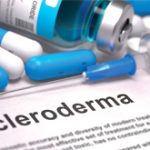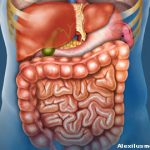WASHINGTON, D.C.—The first treatment option for most kinds of scleroderma bowel disease, or gastrointestinal involvement related to scleroderma, is lifestyle change—but proven medical treatments are hard to come by and are severely understudied in this disorder, an expert said at the 2012 ACR/ARHP Annual Meeting, held here November 9–14. [Editor’s Note: This session was recorded and is available via ACR SessionSelect at www.rheumatology.org.]
Most of the medical treatments do not come with a long track record, said John Clarke, MD, clinical director of the Center for Neurogastroenterology at Johns Hopkins University in Baltimore, in a session titled, “Scleroderma Bowel Disease: From Top to Bottom.”
Scleroderma is a systemic process, and the gastrointestinal (GI) tract is the largest organ system in the body except for the skin, so it shouldn’t be surprising that GI involvement is the most frequent internal complication. The esophagus is the most commonly affected organ, but any part of the GI system can be involved, with symptoms from dysphagia to heartburn, vomiting to incontinence. And the complications can be very serious. Severe GI involvement is seen in only about 8% of cases, but among those, only 15% survive more than nine years, Dr. Clarke said.
“Scleroderma does affect the gut within the vast majority of cases,” Dr. Clarke said. “Treatment is geared primarily toward decreasing reflux, reducing the complications associated with it, enhancing gastrointestinal function, avoiding bacterial overgrowth, and optimizing nutrition. Treatments at this point are mainly reactive in nature.” He offered treatment guidance for a variety of symptoms and conditions related to scleroderma bowel disease:
Oropharyngeal
Treatment is limited to lifestyle changes—small bolus sizes, soft foods, liquid supplementation, and dental follow-up.
Esophageal Dysmotility
“Treatment can be somewhat challenging,” Dr. Clarke said. “The scleroderma-specific therapies haven’t been shown to make a difference in terms of gastrointestinal dysfunction. The goal of treatment is certainly to reduce symptoms as well as treat any complications that arise.”
Patients should avoid foods known to slow gastric emptying or decrease sphincter pressure, such as chocolate, high-citrus fruits and juices, onions, garlic, and caffeine. Quitting smoking, avoiding alcohol, elevating the head when sleeping, sleeping on the left side, and not eating within three hours of sleeping are also recommended.
Medically, proton-pump inhibitors are the mainstay, “by far the most effective, but also the most expensive,” Dr. Clarke said. Prokinetics are not great options, but the EULAR Scleroderma Trials and Research (EUSTAR) consensus in 2009 recommended considering them, he said.1
As for endoscopic and surgical options, “there’s really limited data” on whether these work, he said.
Some new therapies on the horizon using electrical stimulation to increase sphincter pressure selectively and a magnet system to increase sphincter pressure also are worth looking out for, he said.
Gastric Dysfunction
For this problem, lifestyle changes should include small-volume, soft-diet, and low-fat meals, along with liquid supplements, Dr. Clarke said.
Prokinetics are the main therapy, he said, with erythromycin the most potent. The efficacy of the drug can tend to trail off with use, so Dr. Clarke recommends treatment for 25 days then a 5-day break before restarting. Metoclopramide, he suggests, should be used with liquid dosing and at the lowest possible dose. Domperidone can be used after submitting a special U.S. Food and Drug Administration (FDA) application, and cisapride was pulled from the market 13 years ago because of a link to significant QT prolongation, but is available for compassionate use, he said.
He said that ginger, shown to improve gastric emptying, might be worth a trial. Myotomy and gastric electrical stimulation has shown some promise, but there are no data in scleroderma specifically.
Watermelon Stomach (Gastric Antral Vascular Ectasia [GAVE])
Treatments are based on “very small case series…there’s not a lot of information to guide use of these,” Dr. Clarke said, but options include argon plasma coagulation, which can be done during a procedure like a colonoscopy while a patient is sedated and involves using argon gas and electrical current to seal bleeding tissue; and cryotherapy, which allows quick treatment of a large area of stomach lining.
Small Intestinal Involvement
Lifestyle changes are also the first choice for treatment here, and prokinetic therapy is the next step—“although the data that suggest that this helps with small bowel dysfunction are certainly less robust” than with stomach involvement, Dr. Clarke said. Octreotide is one therapy, and Dr. Clarke said he generally uses 50 micrograms subcutaneously at night; he cautioned that higher doses tend to decrease stomach emptying. Pryridostigmine acts as a whole gut prokinetic, but there are no data within scleroderma. Dr. Clarke suggests starting with 30 mg before meals for a week, then move to 60 mg if the patient is doing well.
Bacterial therapy is also an option, decreasing gut bacterial contents. This is recommended by EUSTAR but with no guidelines for length of treatment or which agents to use, although Dr. Clarke said he will generally use ciprofloxacin, metronidazole, or rifaximin.
Colon Involvement
Dr. Clarke said that constipation is his most challenging scleroderma-related symptom to treat. “These patients tend to have proximal symptoms, so asking them to increase bulk tends to just worsen the gastroparesis,” he said.
Lubiprostone, the first approved medication, increases fluid secretion from chloride channels in the colon and small bowel. There is also linaclotide, which was approved several months ago. It increases fluid secretion, and Phase III trials found that it might also reduce abdominal pain—so, at least on paper, it “looks like there might be something that works particularly well for these patients,” he said.
Dr. Clarke is encouraged about prucalopride, which seems to have a “more colon-specific role,” he notes. It has been approved in Europe, but not in the U.S.
Fecal Incontinence
This is a surprisingly common but underreported problem, Dr. Clarke said. Lifestyle changes can be made to increase bulk in the stool to soak up fluids, but that approach can be difficult. Physical retraining to increase sphincter tone is another option. Also, over the last two years, two therapies have been FDA approved: the first injectable drug that can be used to bulk up the sphincter area (Solesta) and sacral nerve stimulation, in which electrical impulses are sent to the nerves that regulate the sphincter muscle.
Thomas Collins is a freelance medical journalist based in Florida.



